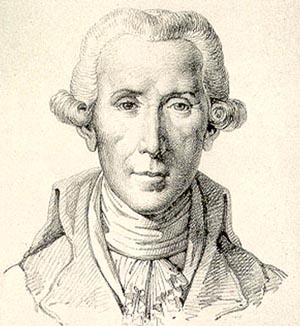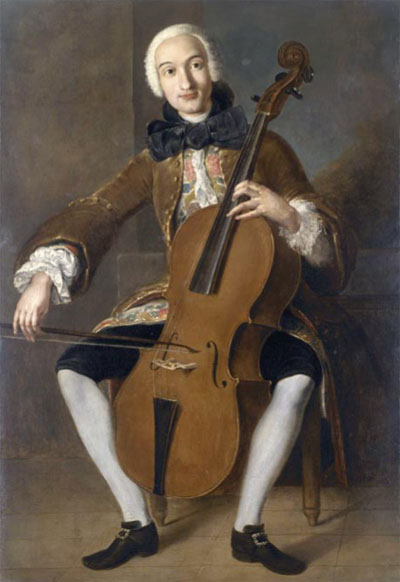<Back to Index>
- Physical Chemist Svante August Arrhenius, 1859
- Composer Luigi Rodolfo Boccherini, 1743
- King of the Netherlands Willem III, 1817
PAGE SPONSOR


Luigi Rodolfo Boccherini (February 19, 1743 – May 28, 1805) was an Italian classical era composer and cellist whose music retained a courtly and galante style while he matured somewhat apart from the major European musical centers. Boccherini is most widely known for one particular minuet from his String Quintet in E, Op. 11, No. 5 (G 275), and the Cello Concerto in B flat major (G 482). This last work was long known in the heavily altered version by German cellist and prolific arranger Friedrich Grützmacher, but has recently been restored to its original version. Boccherini's music was influenced by Spanish and Mediterranean music in that he composed several quintets for guitar.
Boccherini was born in Lucca, Italy, into a musical family. At a young age he was sent by his father, a cellist and double bassplayer, to study in Rome. In 1757 they both went to Vienna where they were employed by the court as musicians in the Burgtheater. In 1761 Boccherini went to Madrid, where he was employed by Infante Luis Antonio of Spain, younger brother of King Charles III. There he flourished under royal patronage, until one day when the King expressed his disapproval at a passage in a new trio, and ordered Boccherini to change it. The composer, no doubt irritated with this intrusion into his art, doubled the passage instead, leading to his immediate dismissal. Then he accompanied Don Luis to Arenas de San Pedro, a little town at the Gredos mountains; there and in the closest town of Candeleda, Boccherini wrote many of his most brilliant works.
Among his late patrons was the French consul Lucien Bonaparte, as well as King Friedrich Wilhelm II of Prussia, himself an amateur cellist, flautist,
and avid supporter of the arts. Boccherini fell on hard times following
the deaths of his Spanish patron, two wives, and two daughters, and he
died almost in poverty in Madrid in 1805, being survived by two sons.
His blood line continues to this day in Spain. Much of his chamber music follows models established by Joseph Haydn;
however, Boccherini is often credited with improving Haydn's model of
the string quartet by bringing the cello to prominence, whereas Haydn
had always relegated it to an accompaniment role. Rather, some sources
for Boccherini's style are in the works of a famous Italian cellist, Giovanni Battista Cirri, who was born before Boccherini and before Haydn, and in the Spanish popular music. A virtuoso cellist of high caliber, Boccherini often played violin repertoire on the cello, at pitch,
a skill he developed by substituting for ailing violinists while
touring. This supreme command of the instrument brought him much praise
from his contemporaries (notably Pierre Baillot, Pierre Rode, and Bernhard Romberg),
and is evident in the cello parts of his compositions (particularly in
the quintets for two cellos, treated often as cello concertos with string quartet accompaniment). He
wrote a large amount of chamber music, including over one hundred
string quintets for two violins, viola and two cellos (a type which he
pioneered, in contrast with the then common scoring for two violins,
two violas and one cello), a dozen guitar quintets, not all of which
have survived, nearly a hundred string quartets, and a number of string trios and sonatas (including at least 19 for the cello). His orchestral music includes around 30 symphonies and 12 virtuoso cello concertos. Boccherini's works have been catalogued by the French musicologist Yves Gérard (born 1932) in the Gérard catalog, published in London (1969), hence the "G" numbers applied to his output. With
a ministerial decree dated 27 April 2006, the Opera Omnia of the
composer Luigi Boccherini was promoted to the status of Italian National Edition. Boccherini's style is characterized by the typical Rococo charm,
lightness, and optimism, and exhibits much melodic and rhythmic
invention, coupled with frequent influences from the guitar tradition
of his adopted country, Spain. Part of manuscripts with his compositions are housed in the Biblioteca comunale Luciano Benincasa. Neglected after his death — the dismissive sobriquet "Haydn's
wife" dates from the nineteenth century — his works have been gaining
more recognition lately, in print, record, and concert hall. His
"celebrated minuet" (String Quintet in E, Op. 11, No. 5 (G 275)) was popularized through its use in the film The Ladykillers while his famous "Musica notturna delle strade di Madrid" (String Quintet in C Major, Op. 30 No. 6, G324), became popular through its use in films such as Master and Commander: The Far Side of the World. His
distinctive compositions for string quintet (two violins, one viola,
two cellos), long neglected after his death, have been brought back to
life by the Boccherini Quintet in
the second half of the 20th century, when two of its founding members
discovered a complete collection of the first edition of the 141 string
quintets in Paris and began playing and recording them around the world.